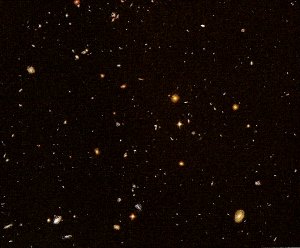A Dime’s Worth of Difference
by Hugh Ross, Ph.D. | Connections Magazine | Volume 8, Number 4
The Hubble Ultra Deep Field. This Hubble Space Telescope image is the deepest penetration of the universe ever achieved with an optical telescope. Every bright spot or smudge is a galaxy (except for the few foreground stars identifiable by cross-like optical defects). The image shows galaxies as distant as 13.3 billion light years, which means they must be the first galaxies ever formed in all of cosmic history.
 |
The universe is incredibly massive. Nevertheless, its mass must be spectacularly fine-tuned for life to be possible. Exactly how massive the universe is remained unknown until astronomers focused the Hubble Space Telescope on a patch of sky no bigger than a tenth the Moon’s (angular) diameter, and held it there for some 278 hours. This Ultra Deep Field (see figure) successfully imaged all the galaxies (at least those bigger than dwarfs) that exist in that region.
The field contains roughly 10,000 galaxies. By extrapolation, then, astronomers determine that the entire observable universe contains at least 2000 billion galaxies. These galaxies contain an estimated average of 200 billion stars each. The total number of stars in these galaxies, then, is 40 billion trillion. The unobserved dwarf galaxies would contribute an estimated additional 10 billion trillion. Thus, the total number of stars in the observable universe adds up to about 50 billion trillion.
Fifty billion trillion stars—that is an unimaginably enormous universe. And yet the universe is more massive by far. The stars, both those that are still shining and those that have burned out, account for just one percent of the universe’s total mass!
One reason the universe must be so massive is that life requires it. The density of protons and neutrons determines how much of the universe’s hydrogen fuses into heavier elements. With a slightly lower density (producing fewer than about 50 billion trillion observable stars), nuclear fusion would be less productive and at no time in cosmic history (either in the big bang or in stars) would elements heavier than helium be produced. Or, if the density were slightly higher (producing more than about 50 billion trillion observable stars), nuclear fusion would be so productive that only heavier-than-iron elements would exist. Either way, life-essential elements such as carbon, nitrogen, oxygen, and phosphorous would be too scarce or nonexistent.
Another life-related reason the universe must be so massive is that the cosmic mass critically influences the universe’s expansion rate. If the mass density were smaller, the influence of gravity would be too weak for stars like the Sun and planets like Earth to form. On the other hand, if the mass density were greater, only stars much larger than the Sun would form. Either way, the universe would contain no stars like the Sun or planets like Earth, and life would have no possible home. The required fine-tuning is so extreme (on part in a quadrillion quadrillion quadrillion quadrillion) that if one were to remove or add a single dime’s worth of mass to this vast cosmos, the balance of the observable universe would be thrown off and physical life would not be possible. Such amazing fine-tuning suggests the involvement of a supernatural, superintelligent Creator.
